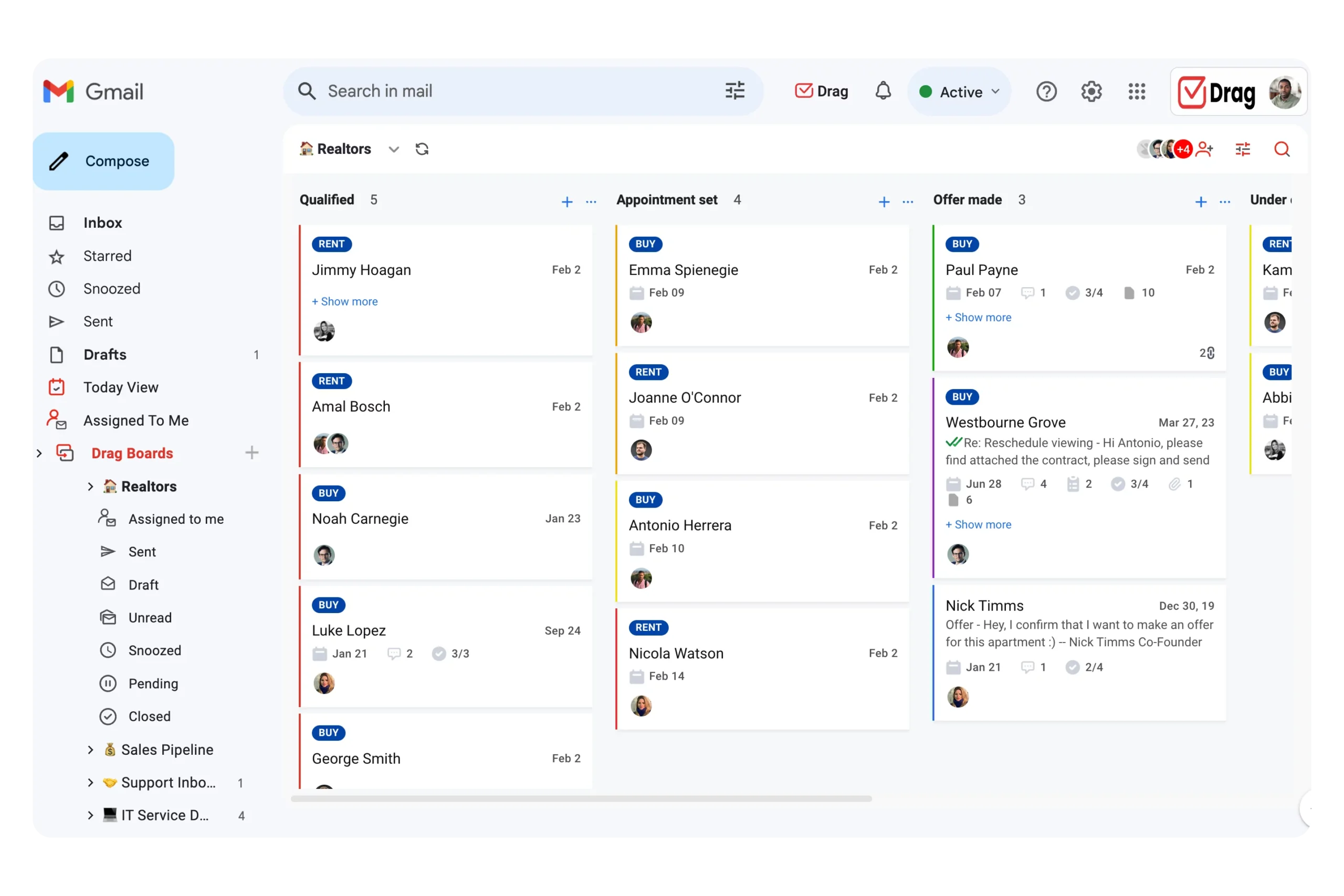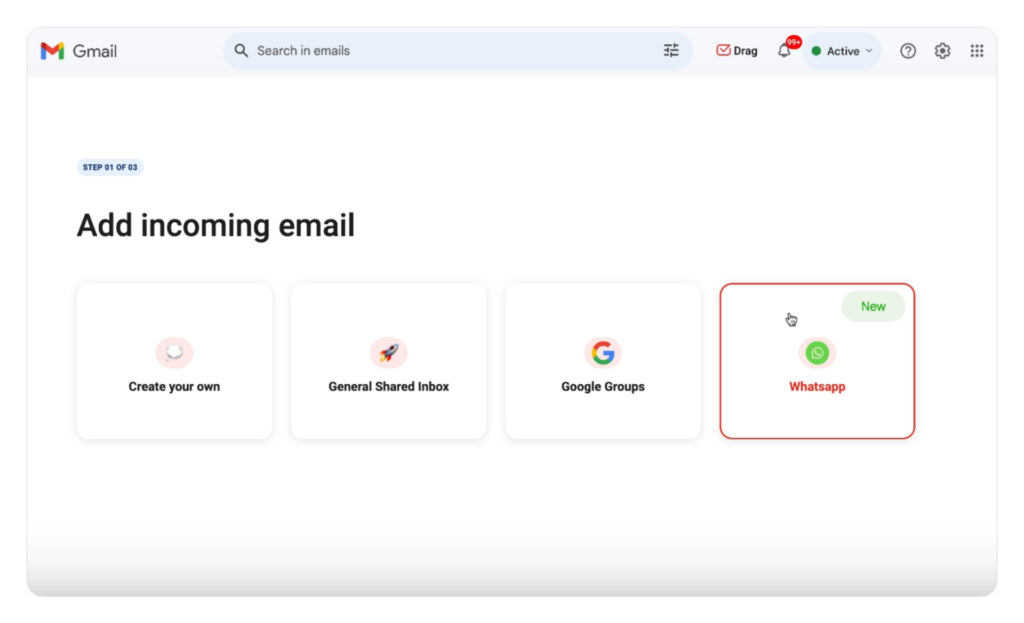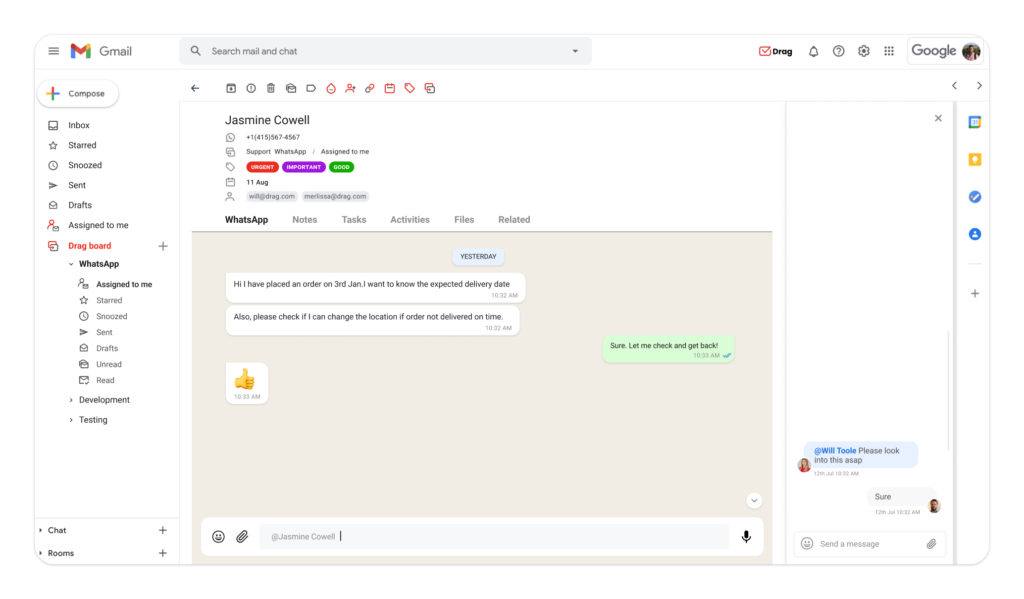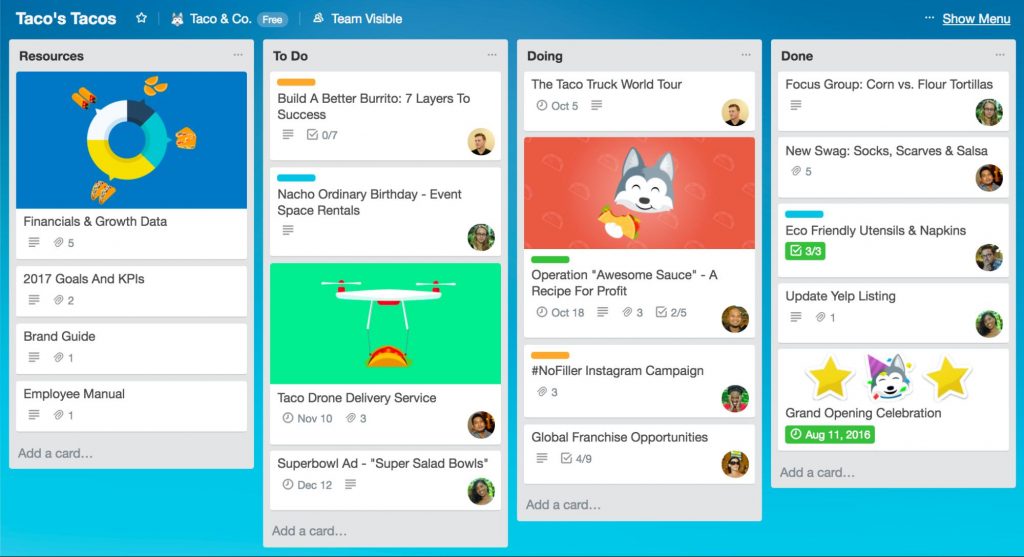
In today’s digital workspace, companies should find efficient ways to stay connected. Whether it’s for team interactions or client accessibility, the tools matter. This is why managers should learn about WhatsApp and Gmail’s ability to complement each other.
This is due to each channel’s priorities and strengths. Gmail has solidified itself as the main email client across personal and professional communications. WhatsApp for teams, on the other hand, revolutionized instant messaging.
So before you integrate WhatsApp and Gmail, let’s look into why it matters, the best ways to do it and good practices to keep in mind.
Why should you integrate WhatsApp and Gmail?
Integrating WhatsApp and Gmail comes with many benefits for businesses. Especially those in need of reliable communication strategies.
Whether it’s improving internal or external conversations, this integration helps streamline operations and enhance customer satisfaction rates.
Considering how often communication makes or breaks a company’s success, leveraging the strengths of both WhatsApp and Gmail can give businesses a great start.
Here’s a deeper look into how these tools improve collaborator and customer engagement:
Internal communications
Internal communication makes the biggest difference in an organization. It ensures everyone in the company is on the same page, fostering collaboration and efficiency.
Usually, teams opt for email as the primary method for internal communication. And Gmail is the most popular platform for business email. However, with the changes in today’s work digital ecosystem, there’s a higher need for instant messaging within teams.
This is where WhatsApp comes into play. WhatsApp’s multimedia instant messaging helps with quick information updates. That means it’s an excellent tool for real-time communication.
By integrating WhatsApp with Gmail, businesses can combine the best of both worlds: email provides structured communication, and WhatsApp the short chats. This integration can lead to more effective communication. Besides, with a well-sorted system, no message is left unseen across channels.
For instance, a team member could receive a critical email from a supplier in Gmail. Then, they can use WhatsApp to discuss the content with collaborators. On the other hand, important conversations that start on WhatsApp can be easily transferred to Gmail for documentation, which ensures that all processes are properly recorded and accessible at a later date.
With this system, there’s a frictionless flow of information within the team, enhancing connection and productivity.
Multichannel customer service
Good customer service metrics are key to your business’s success. Customers expect to be able to reach businesses through various channels, whether it’s via email, social media, phone or chat apps like WhatsApp. Integrating WhatsApp with Gmail allows businesses to offer a truly multichannel customer service experience, ensuring that customers can reach out through a space they already use.
Using WhatsApp for customer service has changed the possibilities. Most customers are already familiar with the app’s interface and feel comfortable using it to communicate with businesses. By integrating WhatsApp with Gmail, businesses can centralize and simplify their answers.
For example, a customer asks a question about your product on WhatsApp. The message can be forwarded to the appropriate department via Gmail. When they answer, the service team has to reply to the customer on WhatsApp again.
If there’s a full integration between these apps, teams can access both internal and external conversations from the same space. That allows them to answer quickly. But it also helps when tracking customer interactions across different channels.
More importantly, this integration can improve response times and customer satisfaction rates. WhatsApp notifies the team of any message received, so that they can quickly acknowledge and address customers. Gmail’s filters and labels, by contrast, help teams sort messages by urgency and relevancy.
The dual approach ensures that customers receive timely, effective support, regardless of the platform they choose to use.
CRM strategy
Customer Relationship Management (CRM) is essential for businesses looking to build and maintain strong relationships with their customers. A CRM strategy requires tracking customer interactions, managing leads, and collecting relevant information on their points of contact. Integrating WhatsApp and Gmail into your CRM strategy can enhance your ability to manage customer relationships effectively.
WhatsApp CRM works by providing a direct method to communicate with customers. For example, a sales representative might initiate contact with a lead via WhatsApp, discussing their needs and preferences. On Gmail, you can monitor click-through rates and automate follow-up offers to your clients.
This integration also benefits personalization efforts. With all customer interactions available in your workspace, your team can set up custom offers, increasing the chances of conversion. Customer data from both WhatsApp and Gmail can be used to create targeted campaigns.
Marketing efforts
A campaign’s impact is based on how many reliable potential customers it reaches. And reaching them on different channels can be a game changer. Email marketing has its benefits, and Gmail’s segmentation features make it useful for managing email campaigns. However, with the increasing importance of mobile messaging apps, companies need to look into WhatsApp for marketing teams as well.
WhatsApp offers an instant, more direct path to customers. Unlike email, which can sometimes feel impersonal, WhatsApp messages are typically read and responded to quickly. By integrating WhatsApp with Gmail, businesses can create effective marketing campaigns that reach different steps of their buyers’ journey.
For instance, a business could send a promotional email via Gmail and follow up with a personalized message on WhatsApp. The integration allows the team to track and analyze the campaign’s performance across both platforms. By capturing data from both Gmail and WhatsApp, businesses get insights into which channels are most effective for different segments of their audience.
This integration also makes campaigns more dynamic. WhatsApp’s multimedia features mean your messages can include images and videos. Gmail can be leveraged for product guides and documentation. By combining these tools, businesses can create more engaging marketing experiences for different types of customers.
What’s the data on WhatsApp and Gmail?
There’s also some interesting points when looking into WhatsApp and Gmail statistics. Both tools have free options that offer most of their standard resources. WhatsApp prioritizes multimedia, quick and individual chats with segmented lists, Gmail allows for conversation threads with more recipients. This is evident when you check their limitations:
$ free
Per Month- 2 billion active users
- Files are limited to 2GB
- Max 256 contacts for broadcast lists
- Groups can contain up to 512 users
- Backup and storage are limited to your phone’s memory
Gmail
$ free
Per Month- 1.8 billion users
- Files up to 10GB*
- Up to 2000 recipients per message
- Unlimited members on Google Groups
- Storage tied to Google Workspace account (from 15GB)
*(via Google Drive)
Turn Gmail into your Team’s Workspace.
- 2.5x faster email responses.
- 20 hours less spent per month, per team member.
- 40% more deadlines achieved and happier teams.
How to integrate WhatsApp and Gmail?
Now that you know the reasons why linking WhatsApp and Gmail benefits your entire workflow, it’s important to understand how to do it. There are two main methods to do it:
Method 1: Task management app
The first one is using a task management tool. These tools can connect to multiple apps in your workflow, including WhatsApp and Gmail.
Here’s how it works: when you create an account, you can set up a project board. There, you can create cards for each task, add deadlines, sort them by status and assign to a team member. Here’s how it looks on Trello, a popular option in this category:
After your board is set up, you can connect the app with Gmail using a browser extension. When you log into your inbox you’ll see a sidebar that helps you add any message to your task list on Trello:
As for WhatsApp, you can connect it through an add-on, like WhatsApp notifications. Made with WhatsApp Business API, it helps your team stay connected with any changes to the task board. That way, they can stay in the loop with all ongoing tasks.
If you’re using a Trello alternative, you can usually find add-ons that connect it to WhatsApp and Gmail, either natively or via Zapier integration.
Limitations
Even though this method is useful and cost-effective, it comes with a few limitations. First, users must manually add incoming tasks to the project board. This takes time and affects workflow, which decreases productivity. Another potential issue with manual updates is that some messages can be overlooked, leading to unfinished conversations.
Of course, the main issue, however, is that users on your team have to sign into the WhatsApp and Gmail inboxes, collect tasks and log out. That’s because you can’t easily share WhatsApp with multiple users. There’s a 10-device limit, so team members have to be mindful of logins.
When you receive a task on Gmail (for example, a customer asking for quotes), you need to copy the message into the task queue so that the assignee can get the full context. That takes even more time.
Method 2: Shared inbox
The second method, however, is potentially more effective. That’s using a shared inbox. A shared inbox is an all-in-one workspace that connects your incoming messages to your workflow. This means your WhatsApp and Gmail conversations are easily accessible from the same spot.
Most shared inbox software allows managers to create and share a Gmail shared inbox. With our solution, DragApp, you can also include a WhatsApp shared inbox in your workspace. Then, all you have to do is add your team members to the workspace and they can easily access everything – no need to log in and out of apps.

The biggest benefit is that Drag automatically turns your WhatsApp and Gmail chats into tasks. That means you can cut a few steps in your productivity journey and complete tasks much faster.
Other resources on a shared inbox simplify your digital operations. One of them is workspace routing. You can create custom automation rules that sort and send tasks to the right teams, for example. No more CC’ing and BCCing. Instead, collaborators get their updates directly to them. You can create rules based on subject lines, keywords, senders, and so on.

One caveat when doing multichannel work is that, often, conversations happen on different platforms. For example, your sales team is working on a service deal with a company. Some contacts are WhatsApp-based, while others rely on Gmail. With Drag, you can merge cards about the same task. That way, you can keep up with deadlines, updates, and checklists from both checkpoints on a single card.
Using a shared inbox for WhatsApp and Gmail: a step-by-step guide
Drag is a Google Workspace app, so the first thing you need to do is connect it to your Workspace account. That will create a Gmail-based collaboration space for your team. It’s pretty straightforward:
- Sign up for a Drag account.
- Download the Chrome extension.
- Select the Gmail account you want to install Drag on and allow the required permissions.
- With that, your Gmail workspace is ready to use.

To connect to WhatsApp, here’s what you need to do:
- Open your Gmail on your browser;
- Click on the Drag icon on the top right;
- The next screen will ask what kind of workspace you need. Select WhatsApp:

- Use your business WhatsApp credentials to log in;
- You’ll receive a confirmation message to authenticate the connection;
- With that, your WhatsApp messages are now part of your shared inbox:

However, to fully benefit from a shared inbox’s WhatsApp and Gmail integration, you need to add the whole team. To do this, follow these steps:
- Be sure to log into the inbox you want to share;
- Go to the left sidebar and click on Boards;
- Then, Share board with team;

- Scroll to Invite member and add your team’s emails;
- Then Send! Now your team has access to the WhatsApp and Gmail shared inbox:

Is linking WhatsApp and Gmail worth it?
By including both WhatsApp and Gmail in a collaborative workspace, you make sure your team can view, manage, and reply to messages across platforms. This benefits productivity and allows for a frictionless workflow. People can check their tasks and any relevant information directly from the messages themselves, no need to update at each step.
With that, your team is faster, more efficient and happier. That translates well into a functional, collaborative and growth-oriented effort.
Turn Gmail into your Team’s Workspace.
- 2.5x faster email responses.
- 20 hours less spent per month, per team member.
- 40% more deadlines achieved and happier teams.









